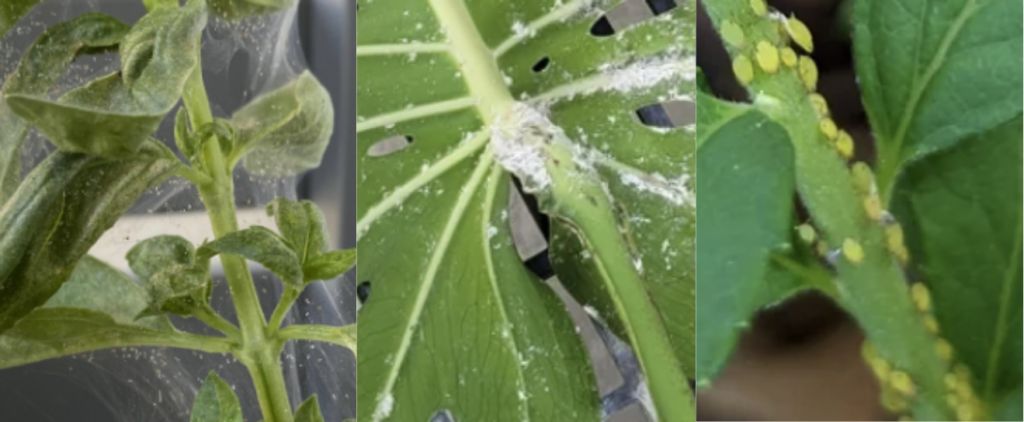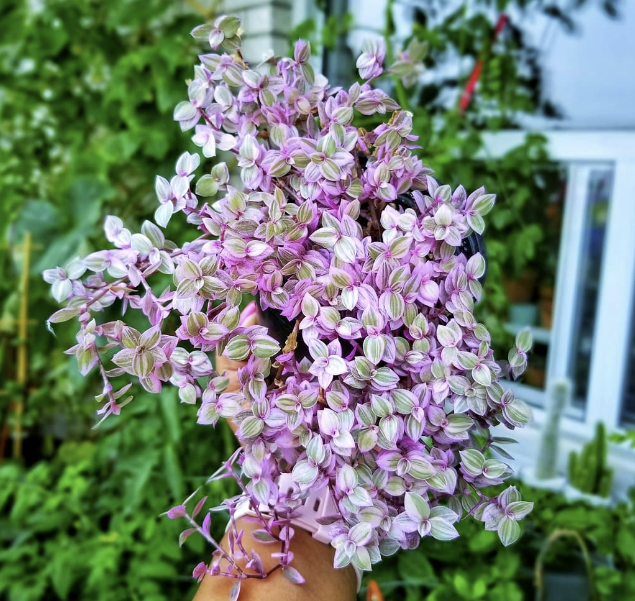The Pink Panther plant, also known as Callisia repens ‘Pink Panther’, is a stunning and versatile houseplant beloved by plant lovers worldwide.
With its vibrant pink leaves, trailing growth habit, and compact size, it brings a cheerful pop of color to any living space.
Whether displayed in a hanging basket, used as ground cover in warm climates, or nestled on a shelf, the Pink Panther plant is a delightful choice for plant lovers.
One of the best things about this plant is its adaptability and ease of care. It’s a low-maintenance plant that can thrive in various indoor conditions, making it an excellent option for beginners and seasoned indoor plant experts.
If you’re looking for a unique and colourful addition to your plant collection, the Pink Panther plant is an ideal choice.
How to Identify a Pink Panther Plant
The PinHow to Identify a Pink Panther Plant
The Pink Panther plant is instantly recognizable by its small, waxy, and soft leaves that feature a mix of green, purple, and pink hues. When healthy, the plant forms a dense, cascading mat of foliage that trails beautifully, making it perfect for hanging baskets or creeping ground cover.
Common Names:
- Pink Panther Plant
- Callisia Pink Panther
- Pink Lady Turtle Vine
- Turtle Vines
During the growing season, you might even see small white flowers emerge, adding another charming detail to this plant’s appearance.
Size
The Pink Panther plant has a compact, trailing growth habit. It typically grows to about 2-4 inches in height and spreads up to 12 inches wide. Its size and growth pattern make it an excellent choice for decorating tight spaces, shelves, and living spaces where a splash of color is needed.
Care

Light Requirements
For optimal growth, the Pink Panther plant thrives in bright indirect light. Providing the right light conditions is crucial for maintaining its vibrant pink leaves and healthy growth.
Care Tips:
- Place your plant near an east-facing window where it can receive filtered sunlight. This ensures the plant gets enough light without the risk of scorching.
- If the plant’s pink coloration starts to fade, it may need a brighter spot. However, avoid direct sunlight, as it can damage the delicate leaves and cause brown spots.
- In low-light conditions, consider using a grow light to supplement natural light.
Watering Schedule
The Pink Panther plant prefers a consistent watering schedule to keep the soil slightly moist but never soggy. Overwatering can lead to root rot, while underwatering can cause the plant to wilt.
Tips:
- Water when the top inch of soil feels dry to the touch.
- Use room-temperature, filtered water whenever possible to avoid leaf discoloration from hard water.
- During the warmer months, water approximately once a week. In the dormant season (winter), reduce watering to once every two weeks.
- Always check that the pot has a drainage hole to prevent water from pooling at the bottom.
Temperature
The Pink Panther plant thrives in warm conditions. To ensure its health, keep it in an environment with consistent room temperatures between 65°F and 80°F.
Key Considerations:
- Protect the plant from cold drafts, air conditioning vents, and sudden temperature changes, which can stress the plant.
- Avoid exposing it to temperatures below 50°F, as the plant is not cold-tolerant and may experience leaf damage or stunted growth.
Humidity
Humidity plays a vital role in maintaining the health and vibrancy of the Pink Panther plant’s foliage. This plant thrives in high humidity levels of 50-60% or more.
Tips to Increase Humidity:
- Place a pebble tray filled with water beneath the plant. As the water evaporates, it creates a more humid environment.
- Use a humidifier to maintain consistent humidity levels, especially during the winter months when indoor air tends to be dry.
- Grouping your Pink Panther plant with other houseplants can naturally increase the humidity in the area.
- Mist the plant occasionally, but avoid over-misting, as excessive moisture on the leaves can lead to pest infestations like spider mites.
Soil Requirements
The Pink Panther plant requires well-draining soil to prevent issues like root rot. A mix that retains some moisture without becoming waterlogged is ideal.
Recommendations:
- Use a light, airy potting mix designed for succulents or cacti.
- Mix in perlite or sand to improve drainage.
- Adding a small amount of organic matter can enhance the soil’s nutrient content while maintaining good drainage.
Fertilizer
Fertilize your Pink Panther plant during its growing season, which spans from spring to late spring through summer. A little feeding goes a long way in promoting new growth and keeping the foliage vibrant.
Tips:
- Use a balanced liquid fertilizer diluted to half strength.
- Apply once a month during the growing season.
- Refrain from fertilizing during the dormant season, as the plant’s growth naturally slows.
Potting
Choose a shallow pot with a drainage hole to accommodate the Pink Panther plant’s shallow root system. Repot every 1-2 years to refresh the soil and give the roots room to spread.
Key Tips:
- Use a pot that is slightly larger than the plant’s current size.
- Ensure the new pot contains fresh, well-draining soil.
- Repotting during the early spring is ideal, as this is when the plant begins its active growth phase.
Pruning
Regular pruning helps maintain the plant’s compact, lush appearance and encourages new growth.
How to Prune:
- Use clean shears to remove leggy or overgrown stems.
- Trim faded or damaged leaves to promote healthy growth.
- Pinch back the tips of stems to encourage bushier growth.
Propagation
The Pink Panther plant is incredibly easy to propagate, allowing you to create new plants to share or expand your collection. Follow these steps:
- Prepare the Cutting:
- Take a 2-3 inch stem cutting just below a leaf node.
- Remove Lower Leaves:
- Strip the leaves from the bottom inch of the cutting to expose the stem.
- Root the Cutting:
- Place the cutting in a container with water or directly into moist soil. If using water, ensure only the stem is submerged, not the leaves.
- Encourage Root Growth:
- Position the cutting in a spot with bright indirect light and maintain high humidity until roots develop.
Pests and Common Issues
Pests:
- Spider Mites: Look for tiny webs on the leaves. Treat by rinsing the plant with water or applying insecticidal soap.
- Mealybugs: Identify white, cottony spots and remove them with a cotton swab dipped in alcohol.
- Aphids: Spray with water or use an insecticidal soap solution.
Pro Tip: Keeping your plant’s leaves clean and well-ventilated can help prevent pest issues.

Common Problems:
- Root Rot: Ensure the plant is not sitting in water and always use well-draining soil.
- Brown Tips: Increase humidity or reduce fertilizer to resolve this issue.
- Fading Pink: Move the plant to a brighter spot with indirect sunlight to restore its color.
Diseases
Pink Panther plants are generally hardy but can sometimes suffer from root rot and leaf spot.
- Root Rot: Often caused by overwatering. If you see yellowing leaves and mushy roots, remove the plant, trim away the rotted roots, and repot in fresh, well-draining soil.
- Leaf Spot: This is caused by fungi and appears as small brown spots on the leaves. Remove affected leaves and avoid getting water on the leaves when watering.
Is It Toxic?
The Pink Panther plant is non-toxic to pets and humans, making it a safe choice for households with curious cats, dogs, or children!
Common Issues
Some common problems you might run into with Pink Panther plants include:
- Brown leaf tips: This usually means the plant needs more humidity or has been over-fertilized.
- Fading color: If the pink fades, your plant might not be getting enough light.
- Wilting: Often a sign of underwatering or that the plant is too cold.
Difficulty Level
The Pink Panther plant is generally easy to care for, making it a great choice for beginners or anyone looking to add a pop of color to their home.
Commonly Asked Questions
- Why is my Pink Panther plant not growing leaves?
- Your plant may not be getting enough light or nutrients. Check for pest infestations or poor soil quality.
- How can I tell if my plant needs more light?
- Fading pink coloration and leggy growth are signs of inadequate light. Move the plant to a brighter location with indirect sunlight.
- How do I know when to water my plant?
- Water when the top inch of soil feels dry. Avoid letting the soil become completely dry or overly soggy.
- When should I prune my plant?
- Prune during the growing season to maintain its shape and encourage bushier growth.
Final Thoughts
Caring for a Pink Panther plant is simple and rewarding! With its vibrant pink leaves and easy care, it’s a fun and colorful addition to any plant collection. Keep in mind its preferences for bright light, moderate watering, and high humidity, and your Pink Panther will be happy and healthy in your home. Enjoy watching this beautiful, pink-hued plant brighten up your space!

